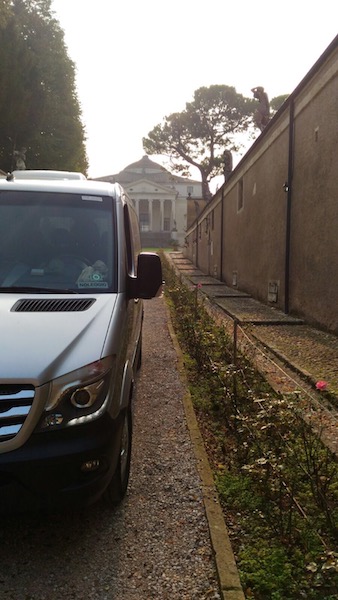“Maybe never architectural art has reached such a level of magnificence” (J. W. Goethe, after the visit at La Rotonda)
La Rotonda is not a villa. It’s something more.
In time it has been visited by poets and artists, sovereigns and statesmen, scholars and art amateurs, travellers and tourists. To everyone La Rotonda has given an unforgettable emotion, that sense of harmony and grace whose answer is a smile, a silence.
After 500 years, La Rotonda today is still a place of pure beauty, waiting to give inspiration, culture, joy.
La Rotonda was projected by Andrea Palladio for Paolo Almerico , works started in 1567 and were quickly completed, by 1571 he was already living at La Rotonda. Paolo Almerico (Vicenza 1514–1589), who was not only a papal prelate but also an intellectual, a member of a refined cultural circle of that time, a poet and a man of letters, who wanted to build for himself a ‘villa’, just out of Vicenza, for his retirement, after a career in Rome at the Papal Court.
Palladio planned 20 villas but only two of them, La Rotonda and Villa Trissino di Meledo (that would never be built) have the peculiar plan that sets them apart: the central round hall with the domed vault, inscribed in a square, with four facades, each with a projecting portico and steps, 6 Ionic columns.
Andrea Palladio intended to transfer into civil architecture a ‘sacred’ inspiration, using a plan already present in religious architecture (such as S. Pietro in Montorio temple in Rome); this idea comes out of his well known archaeological studies and is suggested by many scholars to be derived from the Roman temples. The particular site, the special personality of Paolo Almerico and
Perfect and researched proportions, expression of a measure where tout se tient are in front of the visitor at La Rotonda: you can feel an emotion that touches the spirit.
La Rotonda was also conceived to be in direct relationship with the rural environment, as was typical of Palladio’s villa designs of the period. The villa is not separated from the fields by palisades or closed gardens or edges; it quietly dominates a space composed by fields. Later, between 1580 and 1591, Vincenzo Scamozzi built the ‘barchesse’ that are at the base of the low hill on which the villa sits and which were used as homes for farmers, near the stables and the granaries.
As Palladio underlines in his ‘Quattro Libri’, buildings should be planned in order to expose every room to sunlight and surrounding landscape, and should be easily accessible, with large and harmonious spaces where privacy of the owner is assured together with that of the guests.
The decoration of La Rotonda started at the end of 16th century. Lorenzo Rubini, who is named by Palladio in his book, is thought to have been responsible for the statues on the stairs, whilst Giambattista Albanese those on the porticos and roof. At the beginning of the 17th century, Oddorico Capra commissioned the frescos and stuccoes inside the dome, in the four corners rooms and in the little rooms. The frescos are thought to have been completed by Giambattista and Alessandro Maganza, the stuccoes by Agostino Rubini. The major rooms are enriched with lavish marble fireplaces and beautiful stucco decorated cowls, thought to be by Agostino Rubini and Ottaviano Ridolfi. The floors are made in precious venetian battuto, a special stucco made with a mix of lime and coloured marble grit, whilst in other rooms the floor are laid with hexagonal tiles. The last decorations were made at the beginning of 18th century, when the French painter Louis Dorigny painted the frescos of the hall and the corridors for the wedding of Marzio and Cecilia Capra. The villa was only lightly modified in the following centuries: between 1725 and 1740, the third floor was transformed and divided by Muttoni; until 1750 the attic area was not habitable.
The current state of the villa dates to 1976, at which time the Valmarana family set in place an ongoing program of maintenance, restoration and preservation. The grounds of villa have been open to the public from 1980, and from 1986 access was provided to the interior of the building as well.
“Text taken from the official website of La Rotonda

